PESTE Analysis of Dubai International Airport and its Achievements
VerifiedAdded on 2023/06/09
|16
|3664
|288
AI Summary
This article provides a PESTE analysis of Dubai International Airport and its achievements. It discusses the political, economic, social, technological, and environmental factors affecting the airport's development. It also covers strategies adopted by local authorities to make it a leisure spot and successful products and services that made it a popular travel destination. The article includes financial performance and information about the layout and infrastructure of the airport.
Contribute Materials
Your contribution can guide someone’s learning journey. Share your
documents today.
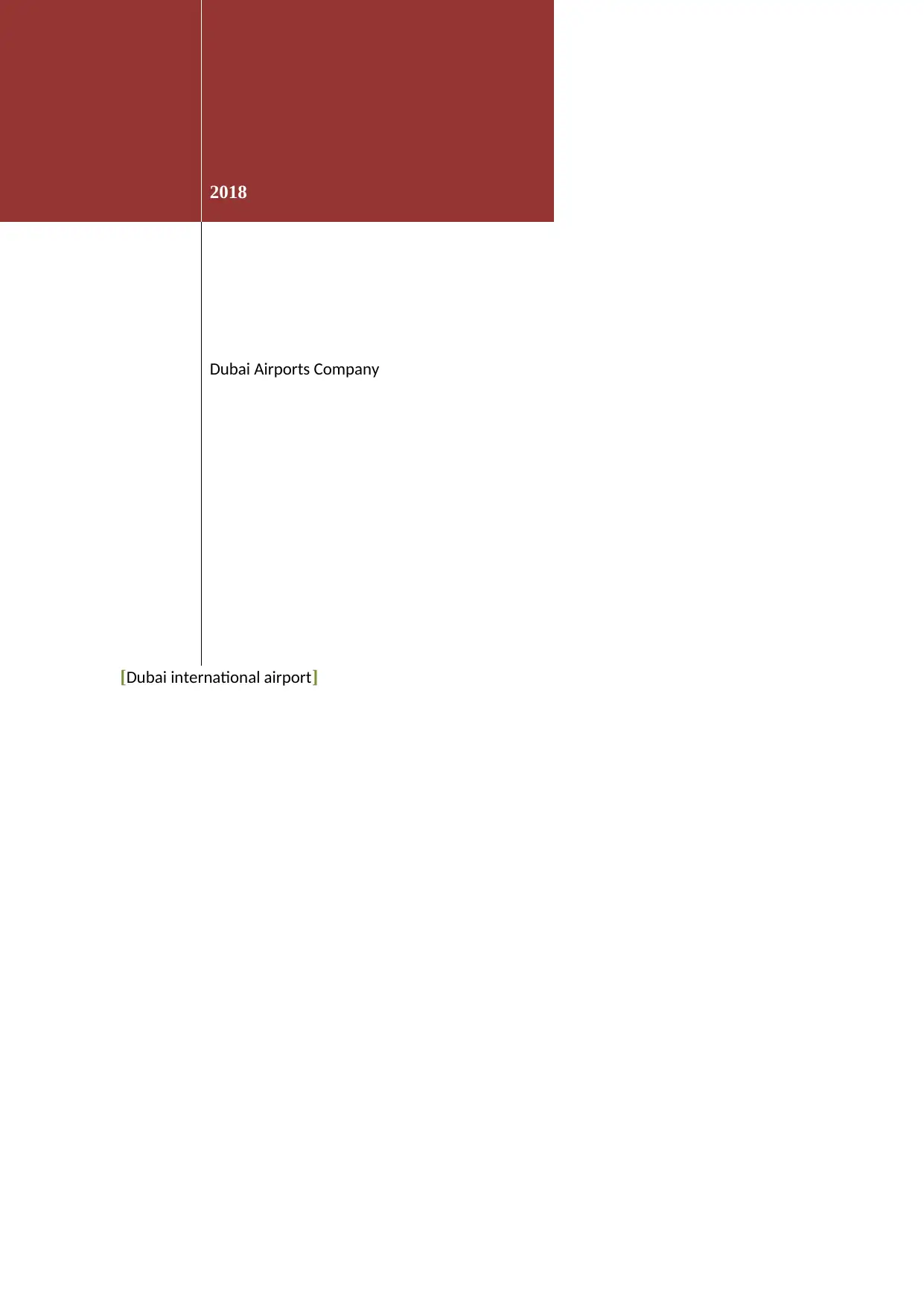
[Dubai international airport]
2018
Dubai Airports Company
2018
Dubai Airports Company
Secure Best Marks with AI Grader
Need help grading? Try our AI Grader for instant feedback on your assignments.
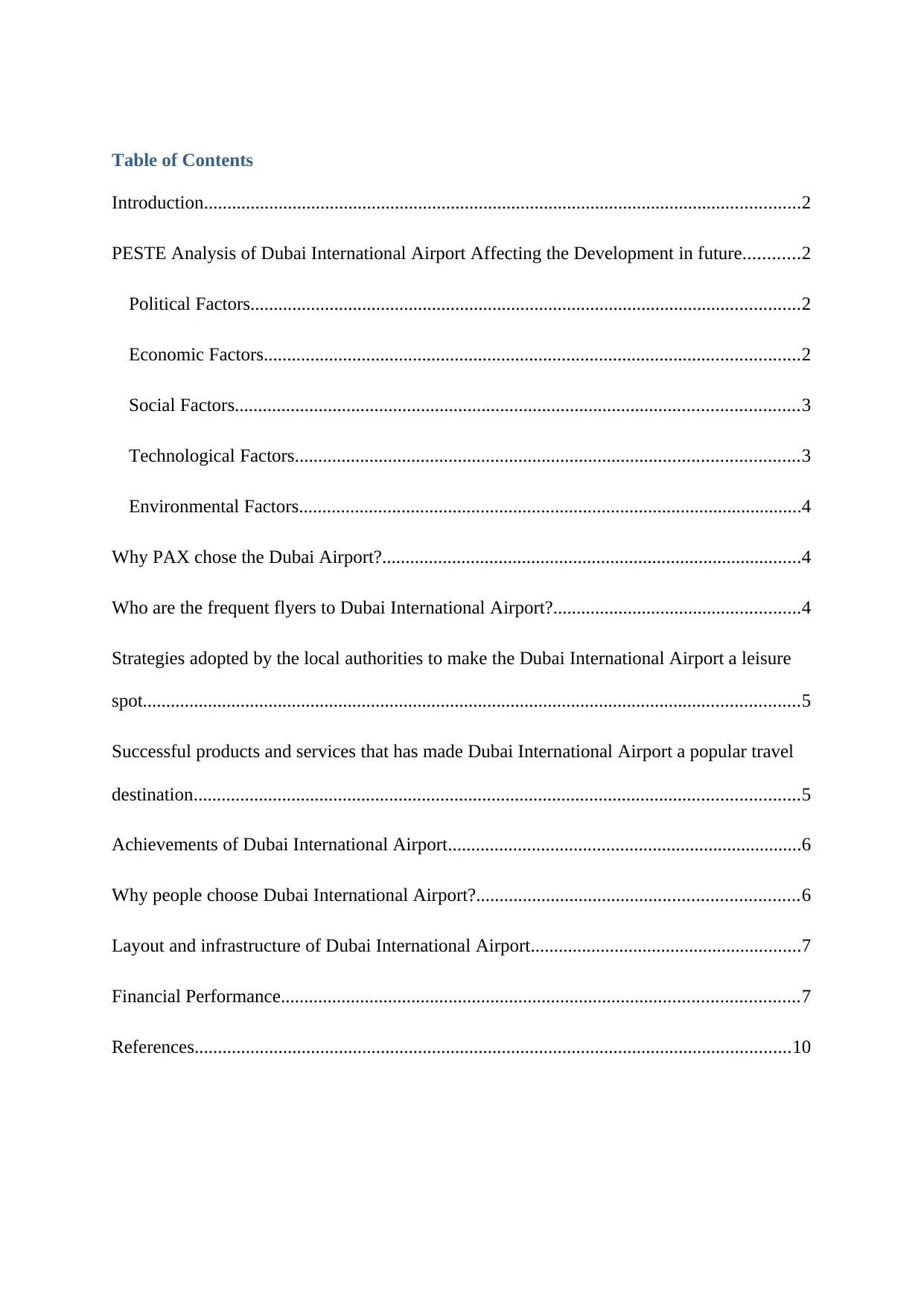
Table of Contents
Introduction................................................................................................................................2
PESTE Analysis of Dubai International Airport Affecting the Development in future............2
Political Factors......................................................................................................................2
Economic Factors...................................................................................................................2
Social Factors.........................................................................................................................3
Technological Factors............................................................................................................3
Environmental Factors............................................................................................................4
Why PAX chose the Dubai Airport?..........................................................................................4
Who are the frequent flyers to Dubai International Airport?.....................................................4
Strategies adopted by the local authorities to make the Dubai International Airport a leisure
spot.............................................................................................................................................5
Successful products and services that has made Dubai International Airport a popular travel
destination..................................................................................................................................5
Achievements of Dubai International Airport............................................................................6
Why people choose Dubai International Airport?.....................................................................6
Layout and infrastructure of Dubai International Airport..........................................................7
Financial Performance...............................................................................................................7
References................................................................................................................................10
Introduction................................................................................................................................2
PESTE Analysis of Dubai International Airport Affecting the Development in future............2
Political Factors......................................................................................................................2
Economic Factors...................................................................................................................2
Social Factors.........................................................................................................................3
Technological Factors............................................................................................................3
Environmental Factors............................................................................................................4
Why PAX chose the Dubai Airport?..........................................................................................4
Who are the frequent flyers to Dubai International Airport?.....................................................4
Strategies adopted by the local authorities to make the Dubai International Airport a leisure
spot.............................................................................................................................................5
Successful products and services that has made Dubai International Airport a popular travel
destination..................................................................................................................................5
Achievements of Dubai International Airport............................................................................6
Why people choose Dubai International Airport?.....................................................................6
Layout and infrastructure of Dubai International Airport..........................................................7
Financial Performance...............................................................................................................7
References................................................................................................................................10
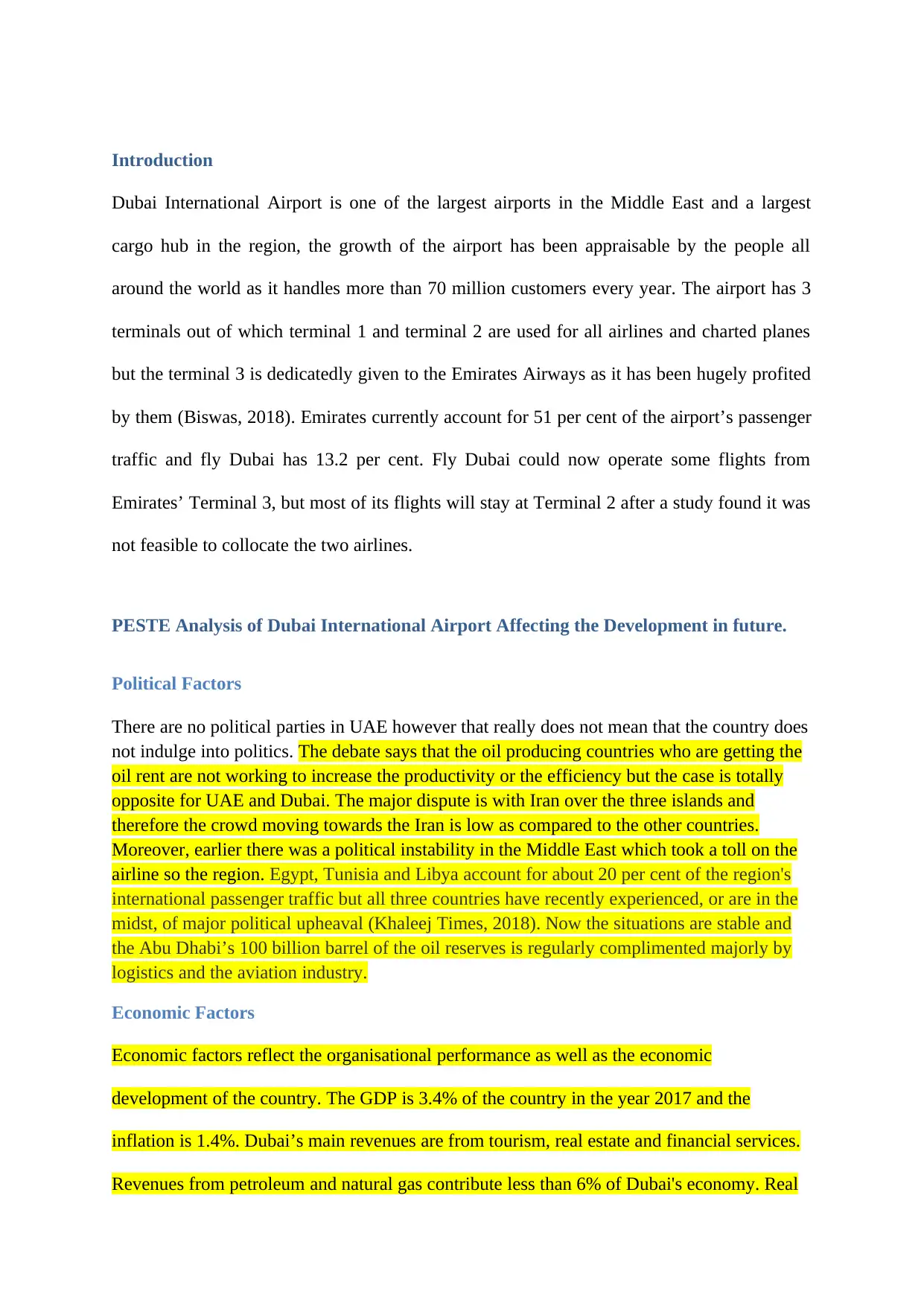
Introduction
Dubai International Airport is one of the largest airports in the Middle East and a largest
cargo hub in the region, the growth of the airport has been appraisable by the people all
around the world as it handles more than 70 million customers every year. The airport has 3
terminals out of which terminal 1 and terminal 2 are used for all airlines and charted planes
but the terminal 3 is dedicatedly given to the Emirates Airways as it has been hugely profited
by them (Biswas, 2018). Emirates currently account for 51 per cent of the airport’s passenger
traffic and fly Dubai has 13.2 per cent. Fly Dubai could now operate some flights from
Emirates’ Terminal 3, but most of its flights will stay at Terminal 2 after a study found it was
not feasible to collocate the two airlines.
PESTE Analysis of Dubai International Airport Affecting the Development in future.
Political Factors
There are no political parties in UAE however that really does not mean that the country does
not indulge into politics. The debate says that the oil producing countries who are getting the
oil rent are not working to increase the productivity or the efficiency but the case is totally
opposite for UAE and Dubai. The major dispute is with Iran over the three islands and
therefore the crowd moving towards the Iran is low as compared to the other countries.
Moreover, earlier there was a political instability in the Middle East which took a toll on the
airline so the region. Egypt, Tunisia and Libya account for about 20 per cent of the region's
international passenger traffic but all three countries have recently experienced, or are in the
midst, of major political upheaval (Khaleej Times, 2018). Now the situations are stable and
the Abu Dhabi’s 100 billion barrel of the oil reserves is regularly complimented majorly by
logistics and the aviation industry.
Economic Factors
Economic factors reflect the organisational performance as well as the economic
development of the country. The GDP is 3.4% of the country in the year 2017 and the
inflation is 1.4%. Dubai’s main revenues are from tourism, real estate and financial services.
Revenues from petroleum and natural gas contribute less than 6% of Dubai's economy. Real
Dubai International Airport is one of the largest airports in the Middle East and a largest
cargo hub in the region, the growth of the airport has been appraisable by the people all
around the world as it handles more than 70 million customers every year. The airport has 3
terminals out of which terminal 1 and terminal 2 are used for all airlines and charted planes
but the terminal 3 is dedicatedly given to the Emirates Airways as it has been hugely profited
by them (Biswas, 2018). Emirates currently account for 51 per cent of the airport’s passenger
traffic and fly Dubai has 13.2 per cent. Fly Dubai could now operate some flights from
Emirates’ Terminal 3, but most of its flights will stay at Terminal 2 after a study found it was
not feasible to collocate the two airlines.
PESTE Analysis of Dubai International Airport Affecting the Development in future.
Political Factors
There are no political parties in UAE however that really does not mean that the country does
not indulge into politics. The debate says that the oil producing countries who are getting the
oil rent are not working to increase the productivity or the efficiency but the case is totally
opposite for UAE and Dubai. The major dispute is with Iran over the three islands and
therefore the crowd moving towards the Iran is low as compared to the other countries.
Moreover, earlier there was a political instability in the Middle East which took a toll on the
airline so the region. Egypt, Tunisia and Libya account for about 20 per cent of the region's
international passenger traffic but all three countries have recently experienced, or are in the
midst, of major political upheaval (Khaleej Times, 2018). Now the situations are stable and
the Abu Dhabi’s 100 billion barrel of the oil reserves is regularly complimented majorly by
logistics and the aviation industry.
Economic Factors
Economic factors reflect the organisational performance as well as the economic
development of the country. The GDP is 3.4% of the country in the year 2017 and the
inflation is 1.4%. Dubai’s main revenues are from tourism, real estate and financial services.
Revenues from petroleum and natural gas contribute less than 6% of Dubai's economy. Real

estate and construction, on the other hand, contributed 22.6% to the economy (Arabian
Business, 2014). The local government should focus on development of the airport which
may result in greater economic importance within the area. As a result the airport will be
benefitted and the operational execution of air terminals is identified with the monetary
development in the nation in which it is found. Global business and exchange movement is
likewise required for the achievement of an airplane terminal. Customs duties are low at
4% with many exemptions, 100% repatriation of capital and profits is permitted. No foreign
exchange controls, no trade barriers or quotas, competitive import duties 4%with many
exemptions (Arabian Business, 2014).
Social Factors
Social environment of a region plays a vital role in the success of the organisation, changes in
such environment affects the industry directly or indirectly. The changes may be positive or
negative which me affect the trade at the airport. Almost 80% of the population in of the
UAE are non-nationals. This is one of the most dramatic defining characteristics of the
overall structure of the demographic environment. The total population of UAE is 5.066
million and globalization is gradually increasing resulting in a mix of many different cultures
within the Emirates (Ziadah, 2018). The Arabs want to work in the public sector and
therefore the employment sector is growing and the opportunities are developing in the
tourism and travelling industry. The DXB is situated at the most reachable situation and the
transport facility is also available.
Technological Factors
The airline industry has been widely affected by the technological changes that are taking
place in the world. Technological changes are great concern for the airline industry. The local
government of the region are now spending more on research and development for the latest
technology, the government is now also making efforts with other countries for the transfer of
Business, 2014). The local government should focus on development of the airport which
may result in greater economic importance within the area. As a result the airport will be
benefitted and the operational execution of air terminals is identified with the monetary
development in the nation in which it is found. Global business and exchange movement is
likewise required for the achievement of an airplane terminal. Customs duties are low at
4% with many exemptions, 100% repatriation of capital and profits is permitted. No foreign
exchange controls, no trade barriers or quotas, competitive import duties 4%with many
exemptions (Arabian Business, 2014).
Social Factors
Social environment of a region plays a vital role in the success of the organisation, changes in
such environment affects the industry directly or indirectly. The changes may be positive or
negative which me affect the trade at the airport. Almost 80% of the population in of the
UAE are non-nationals. This is one of the most dramatic defining characteristics of the
overall structure of the demographic environment. The total population of UAE is 5.066
million and globalization is gradually increasing resulting in a mix of many different cultures
within the Emirates (Ziadah, 2018). The Arabs want to work in the public sector and
therefore the employment sector is growing and the opportunities are developing in the
tourism and travelling industry. The DXB is situated at the most reachable situation and the
transport facility is also available.
Technological Factors
The airline industry has been widely affected by the technological changes that are taking
place in the world. Technological changes are great concern for the airline industry. The local
government of the region are now spending more on research and development for the latest
technology, the government is now also making efforts with other countries for the transfer of
Secure Best Marks with AI Grader
Need help grading? Try our AI Grader for instant feedback on your assignments.
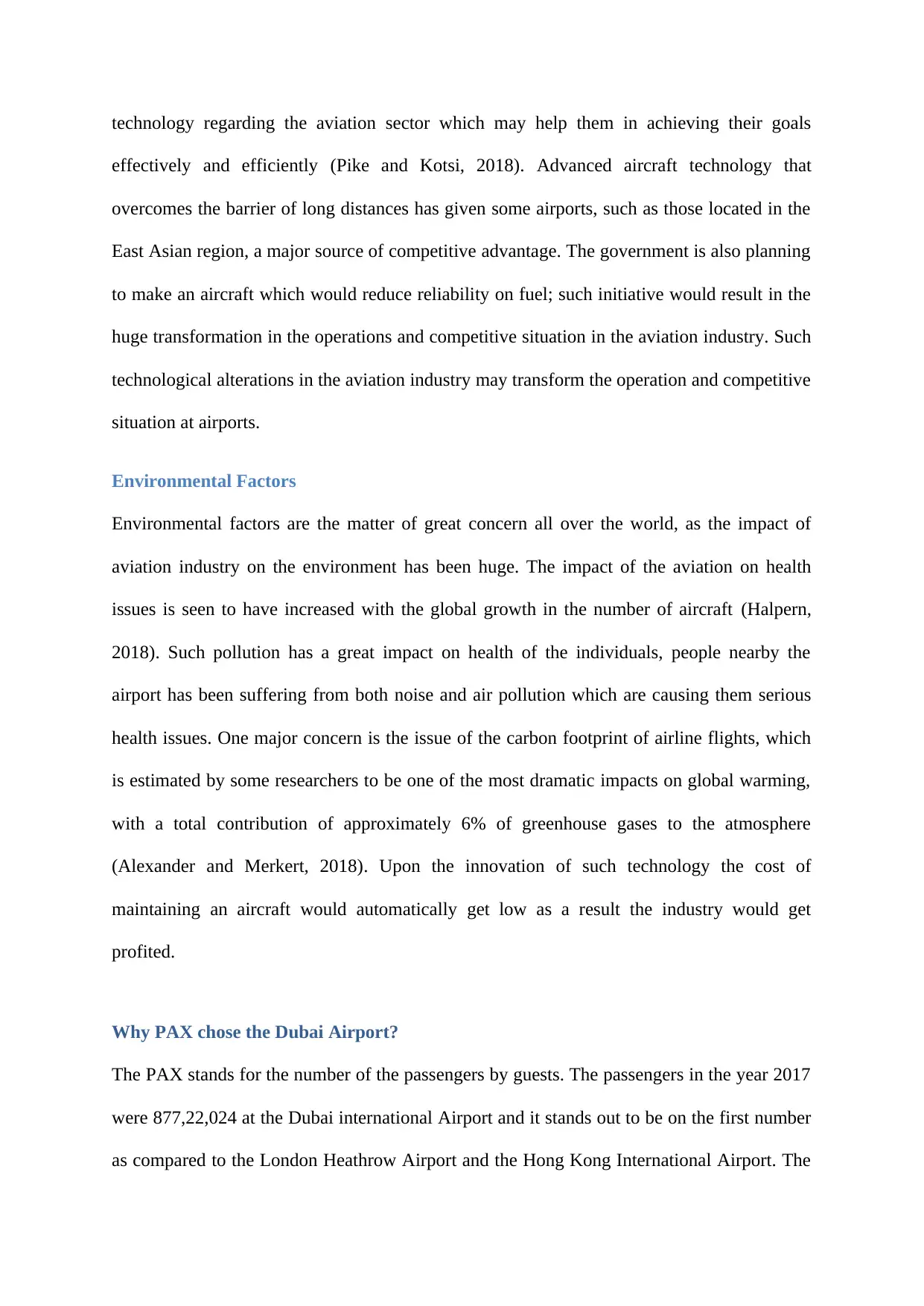
technology regarding the aviation sector which may help them in achieving their goals
effectively and efficiently (Pike and Kotsi, 2018). Advanced aircraft technology that
overcomes the barrier of long distances has given some airports, such as those located in the
East Asian region, a major source of competitive advantage. The government is also planning
to make an aircraft which would reduce reliability on fuel; such initiative would result in the
huge transformation in the operations and competitive situation in the aviation industry. Such
technological alterations in the aviation industry may transform the operation and competitive
situation at airports.
Environmental Factors
Environmental factors are the matter of great concern all over the world, as the impact of
aviation industry on the environment has been huge. The impact of the aviation on health
issues is seen to have increased with the global growth in the number of aircraft (Halpern,
2018). Such pollution has a great impact on health of the individuals, people nearby the
airport has been suffering from both noise and air pollution which are causing them serious
health issues. One major concern is the issue of the carbon footprint of airline flights, which
is estimated by some researchers to be one of the most dramatic impacts on global warming,
with a total contribution of approximately 6% of greenhouse gases to the atmosphere
(Alexander and Merkert, 2018). Upon the innovation of such technology the cost of
maintaining an aircraft would automatically get low as a result the industry would get
profited.
Why PAX chose the Dubai Airport?
The PAX stands for the number of the passengers by guests. The passengers in the year 2017
were 877,22,024 at the Dubai international Airport and it stands out to be on the first number
as compared to the London Heathrow Airport and the Hong Kong International Airport. The
effectively and efficiently (Pike and Kotsi, 2018). Advanced aircraft technology that
overcomes the barrier of long distances has given some airports, such as those located in the
East Asian region, a major source of competitive advantage. The government is also planning
to make an aircraft which would reduce reliability on fuel; such initiative would result in the
huge transformation in the operations and competitive situation in the aviation industry. Such
technological alterations in the aviation industry may transform the operation and competitive
situation at airports.
Environmental Factors
Environmental factors are the matter of great concern all over the world, as the impact of
aviation industry on the environment has been huge. The impact of the aviation on health
issues is seen to have increased with the global growth in the number of aircraft (Halpern,
2018). Such pollution has a great impact on health of the individuals, people nearby the
airport has been suffering from both noise and air pollution which are causing them serious
health issues. One major concern is the issue of the carbon footprint of airline flights, which
is estimated by some researchers to be one of the most dramatic impacts on global warming,
with a total contribution of approximately 6% of greenhouse gases to the atmosphere
(Alexander and Merkert, 2018). Upon the innovation of such technology the cost of
maintaining an aircraft would automatically get low as a result the industry would get
profited.
Why PAX chose the Dubai Airport?
The PAX stands for the number of the passengers by guests. The passengers in the year 2017
were 877,22,024 at the Dubai international Airport and it stands out to be on the first number
as compared to the London Heathrow Airport and the Hong Kong International Airport. The
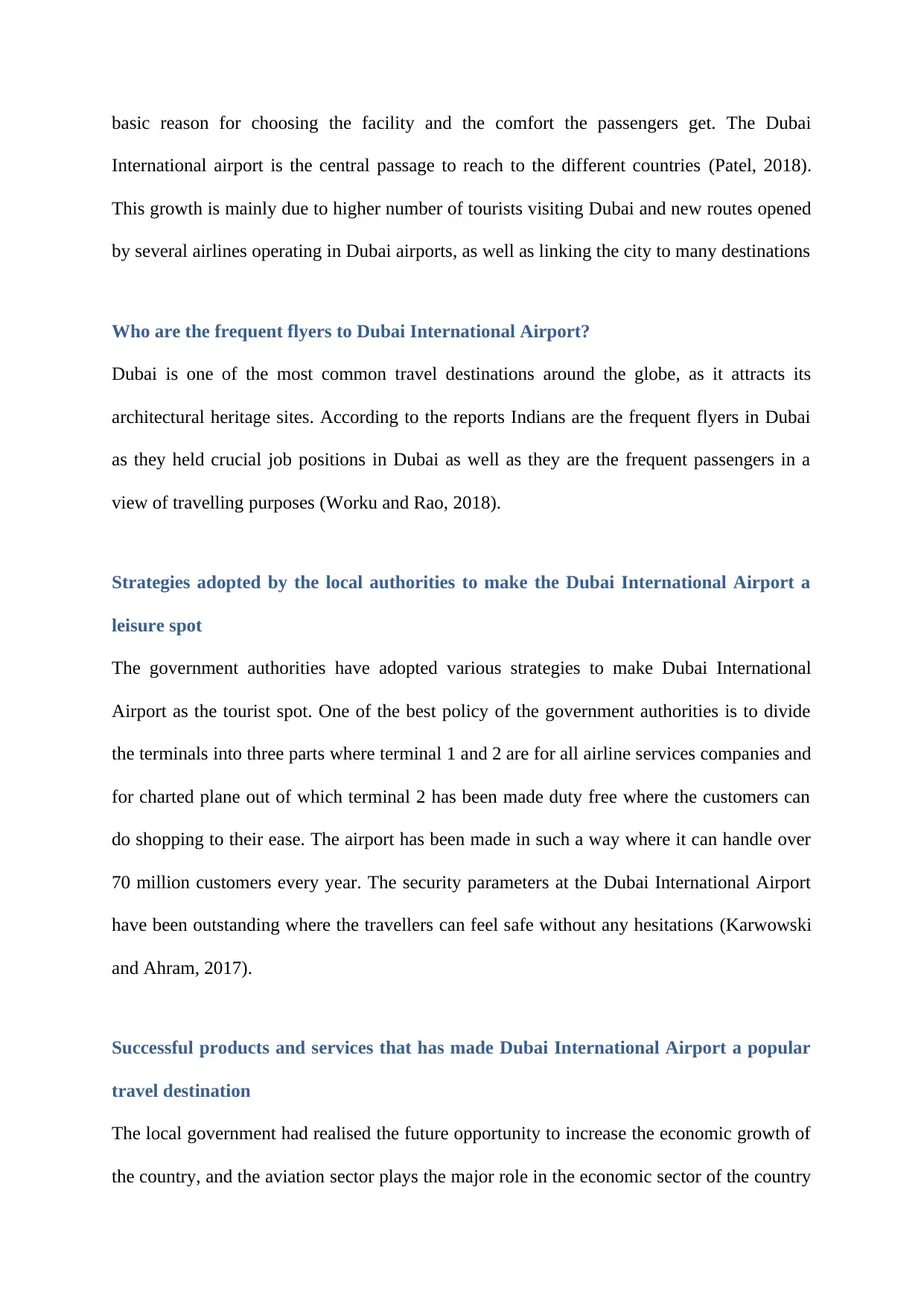
basic reason for choosing the facility and the comfort the passengers get. The Dubai
International airport is the central passage to reach to the different countries (Patel, 2018).
This growth is mainly due to higher number of tourists visiting Dubai and new routes opened
by several airlines operating in Dubai airports, as well as linking the city to many destinations
Who are the frequent flyers to Dubai International Airport?
Dubai is one of the most common travel destinations around the globe, as it attracts its
architectural heritage sites. According to the reports Indians are the frequent flyers in Dubai
as they held crucial job positions in Dubai as well as they are the frequent passengers in a
view of travelling purposes (Worku and Rao, 2018).
Strategies adopted by the local authorities to make the Dubai International Airport a
leisure spot
The government authorities have adopted various strategies to make Dubai International
Airport as the tourist spot. One of the best policy of the government authorities is to divide
the terminals into three parts where terminal 1 and 2 are for all airline services companies and
for charted plane out of which terminal 2 has been made duty free where the customers can
do shopping to their ease. The airport has been made in such a way where it can handle over
70 million customers every year. The security parameters at the Dubai International Airport
have been outstanding where the travellers can feel safe without any hesitations (Karwowski
and Ahram, 2017).
Successful products and services that has made Dubai International Airport a popular
travel destination
The local government had realised the future opportunity to increase the economic growth of
the country, and the aviation sector plays the major role in the economic sector of the country
International airport is the central passage to reach to the different countries (Patel, 2018).
This growth is mainly due to higher number of tourists visiting Dubai and new routes opened
by several airlines operating in Dubai airports, as well as linking the city to many destinations
Who are the frequent flyers to Dubai International Airport?
Dubai is one of the most common travel destinations around the globe, as it attracts its
architectural heritage sites. According to the reports Indians are the frequent flyers in Dubai
as they held crucial job positions in Dubai as well as they are the frequent passengers in a
view of travelling purposes (Worku and Rao, 2018).
Strategies adopted by the local authorities to make the Dubai International Airport a
leisure spot
The government authorities have adopted various strategies to make Dubai International
Airport as the tourist spot. One of the best policy of the government authorities is to divide
the terminals into three parts where terminal 1 and 2 are for all airline services companies and
for charted plane out of which terminal 2 has been made duty free where the customers can
do shopping to their ease. The airport has been made in such a way where it can handle over
70 million customers every year. The security parameters at the Dubai International Airport
have been outstanding where the travellers can feel safe without any hesitations (Karwowski
and Ahram, 2017).
Successful products and services that has made Dubai International Airport a popular
travel destination
The local government had realised the future opportunity to increase the economic growth of
the country, and the aviation sector plays the major role in the economic sector of the country
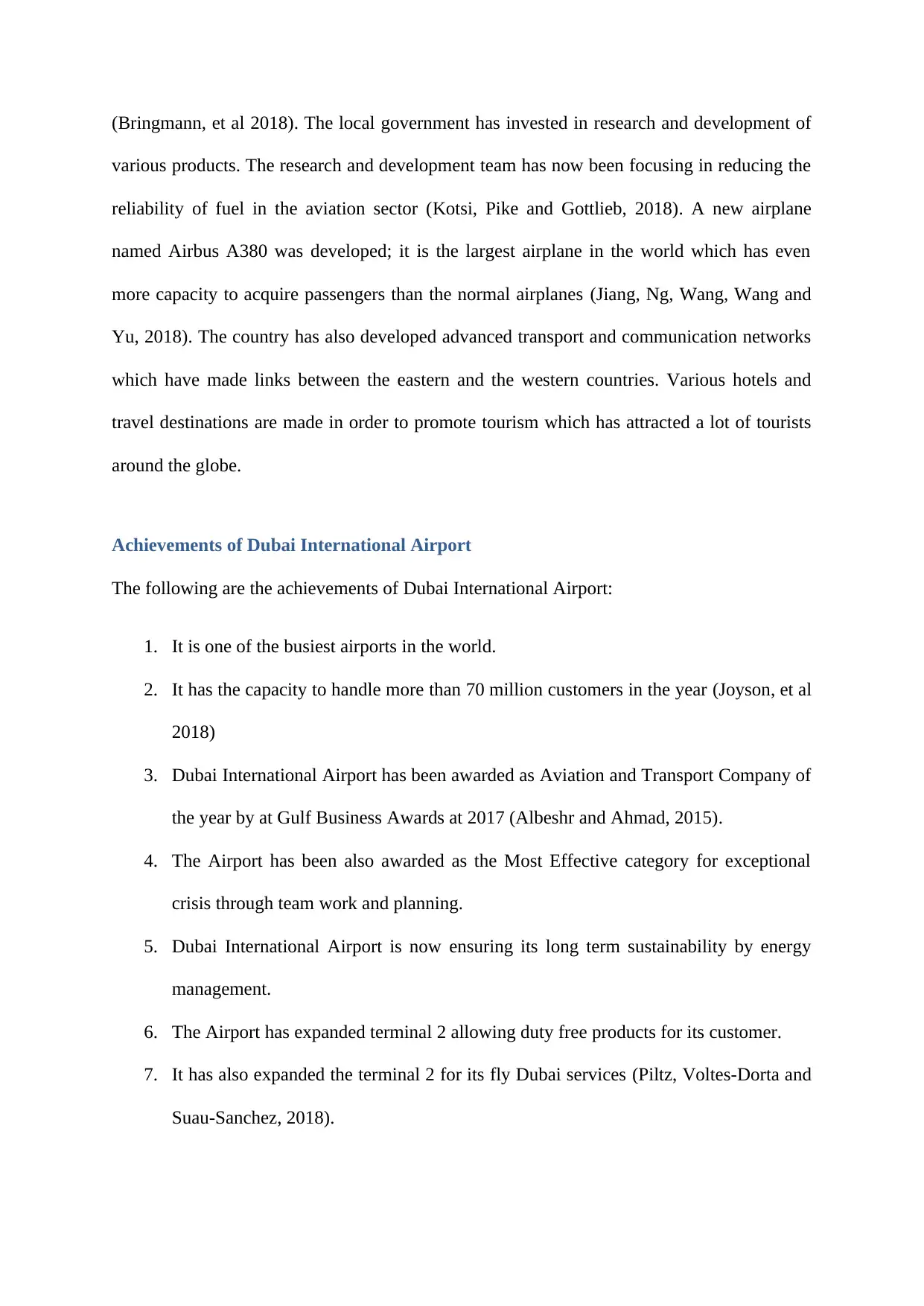
(Bringmann, et al 2018). The local government has invested in research and development of
various products. The research and development team has now been focusing in reducing the
reliability of fuel in the aviation sector (Kotsi, Pike and Gottlieb, 2018). A new airplane
named Airbus A380 was developed; it is the largest airplane in the world which has even
more capacity to acquire passengers than the normal airplanes (Jiang, Ng, Wang, Wang and
Yu, 2018). The country has also developed advanced transport and communication networks
which have made links between the eastern and the western countries. Various hotels and
travel destinations are made in order to promote tourism which has attracted a lot of tourists
around the globe.
Achievements of Dubai International Airport
The following are the achievements of Dubai International Airport:
1. It is one of the busiest airports in the world.
2. It has the capacity to handle more than 70 million customers in the year (Joyson, et al
2018)
3. Dubai International Airport has been awarded as Aviation and Transport Company of
the year by at Gulf Business Awards at 2017 (Albeshr and Ahmad, 2015).
4. The Airport has been also awarded as the Most Effective category for exceptional
crisis through team work and planning.
5. Dubai International Airport is now ensuring its long term sustainability by energy
management.
6. The Airport has expanded terminal 2 allowing duty free products for its customer.
7. It has also expanded the terminal 2 for its fly Dubai services (Piltz, Voltes-Dorta and
Suau-Sanchez, 2018).
various products. The research and development team has now been focusing in reducing the
reliability of fuel in the aviation sector (Kotsi, Pike and Gottlieb, 2018). A new airplane
named Airbus A380 was developed; it is the largest airplane in the world which has even
more capacity to acquire passengers than the normal airplanes (Jiang, Ng, Wang, Wang and
Yu, 2018). The country has also developed advanced transport and communication networks
which have made links between the eastern and the western countries. Various hotels and
travel destinations are made in order to promote tourism which has attracted a lot of tourists
around the globe.
Achievements of Dubai International Airport
The following are the achievements of Dubai International Airport:
1. It is one of the busiest airports in the world.
2. It has the capacity to handle more than 70 million customers in the year (Joyson, et al
2018)
3. Dubai International Airport has been awarded as Aviation and Transport Company of
the year by at Gulf Business Awards at 2017 (Albeshr and Ahmad, 2015).
4. The Airport has been also awarded as the Most Effective category for exceptional
crisis through team work and planning.
5. Dubai International Airport is now ensuring its long term sustainability by energy
management.
6. The Airport has expanded terminal 2 allowing duty free products for its customer.
7. It has also expanded the terminal 2 for its fly Dubai services (Piltz, Voltes-Dorta and
Suau-Sanchez, 2018).
Paraphrase This Document
Need a fresh take? Get an instant paraphrase of this document with our AI Paraphraser
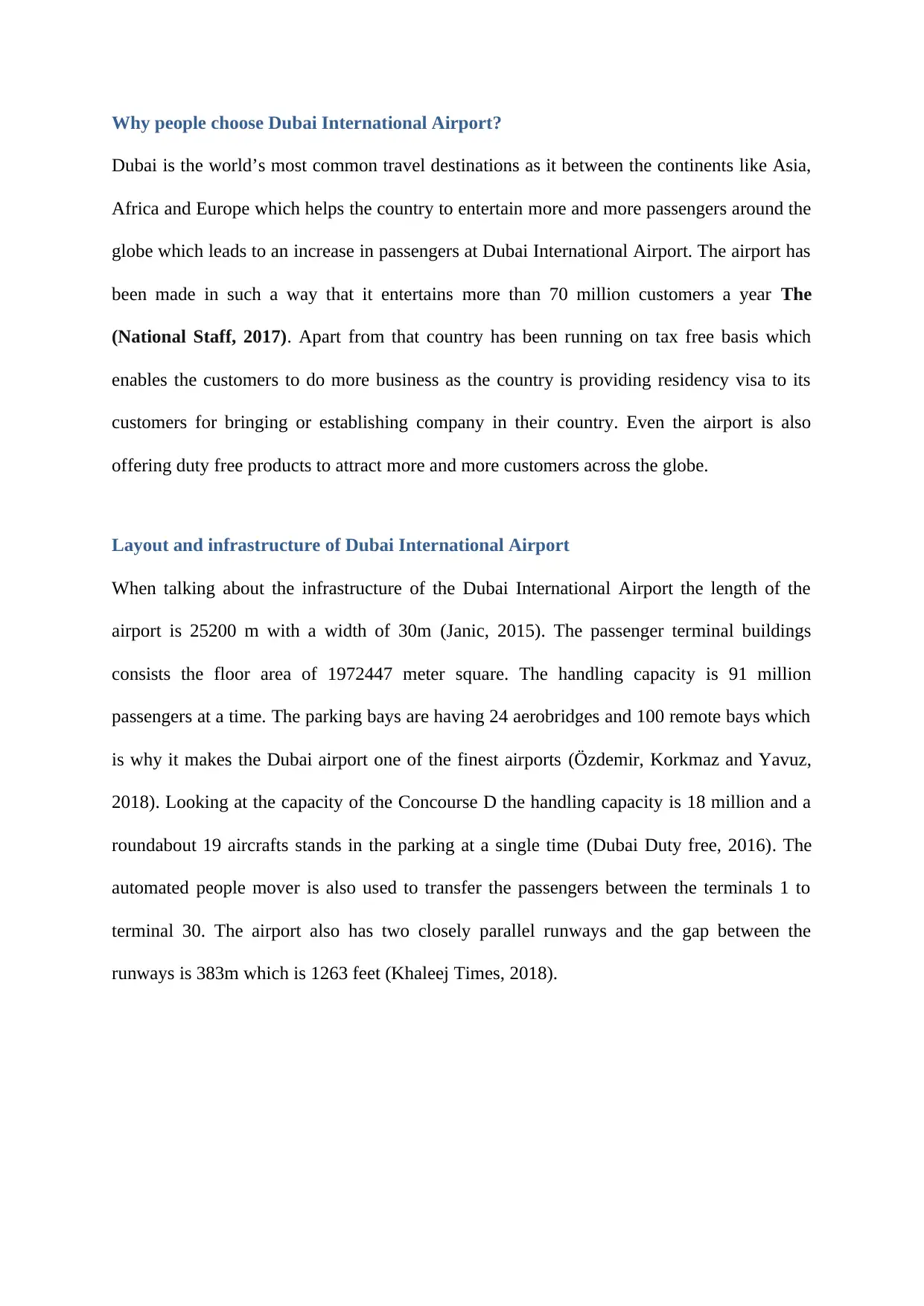
Why people choose Dubai International Airport?
Dubai is the world’s most common travel destinations as it between the continents like Asia,
Africa and Europe which helps the country to entertain more and more passengers around the
globe which leads to an increase in passengers at Dubai International Airport. The airport has
been made in such a way that it entertains more than 70 million customers a year The
(National Staff, 2017). Apart from that country has been running on tax free basis which
enables the customers to do more business as the country is providing residency visa to its
customers for bringing or establishing company in their country. Even the airport is also
offering duty free products to attract more and more customers across the globe.
Layout and infrastructure of Dubai International Airport
When talking about the infrastructure of the Dubai International Airport the length of the
airport is 25200 m with a width of 30m (Janic, 2015). The passenger terminal buildings
consists the floor area of 1972447 meter square. The handling capacity is 91 million
passengers at a time. The parking bays are having 24 aerobridges and 100 remote bays which
is why it makes the Dubai airport one of the finest airports (Özdemir, Korkmaz and Yavuz,
2018). Looking at the capacity of the Concourse D the handling capacity is 18 million and a
roundabout 19 aircrafts stands in the parking at a single time (Dubai Duty free, 2016). The
automated people mover is also used to transfer the passengers between the terminals 1 to
terminal 30. The airport also has two closely parallel runways and the gap between the
runways is 383m which is 1263 feet (Khaleej Times, 2018).
Dubai is the world’s most common travel destinations as it between the continents like Asia,
Africa and Europe which helps the country to entertain more and more passengers around the
globe which leads to an increase in passengers at Dubai International Airport. The airport has
been made in such a way that it entertains more than 70 million customers a year The
(National Staff, 2017). Apart from that country has been running on tax free basis which
enables the customers to do more business as the country is providing residency visa to its
customers for bringing or establishing company in their country. Even the airport is also
offering duty free products to attract more and more customers across the globe.
Layout and infrastructure of Dubai International Airport
When talking about the infrastructure of the Dubai International Airport the length of the
airport is 25200 m with a width of 30m (Janic, 2015). The passenger terminal buildings
consists the floor area of 1972447 meter square. The handling capacity is 91 million
passengers at a time. The parking bays are having 24 aerobridges and 100 remote bays which
is why it makes the Dubai airport one of the finest airports (Özdemir, Korkmaz and Yavuz,
2018). Looking at the capacity of the Concourse D the handling capacity is 18 million and a
roundabout 19 aircrafts stands in the parking at a single time (Dubai Duty free, 2016). The
automated people mover is also used to transfer the passengers between the terminals 1 to
terminal 30. The airport also has two closely parallel runways and the gap between the
runways is 383m which is 1263 feet (Khaleej Times, 2018).
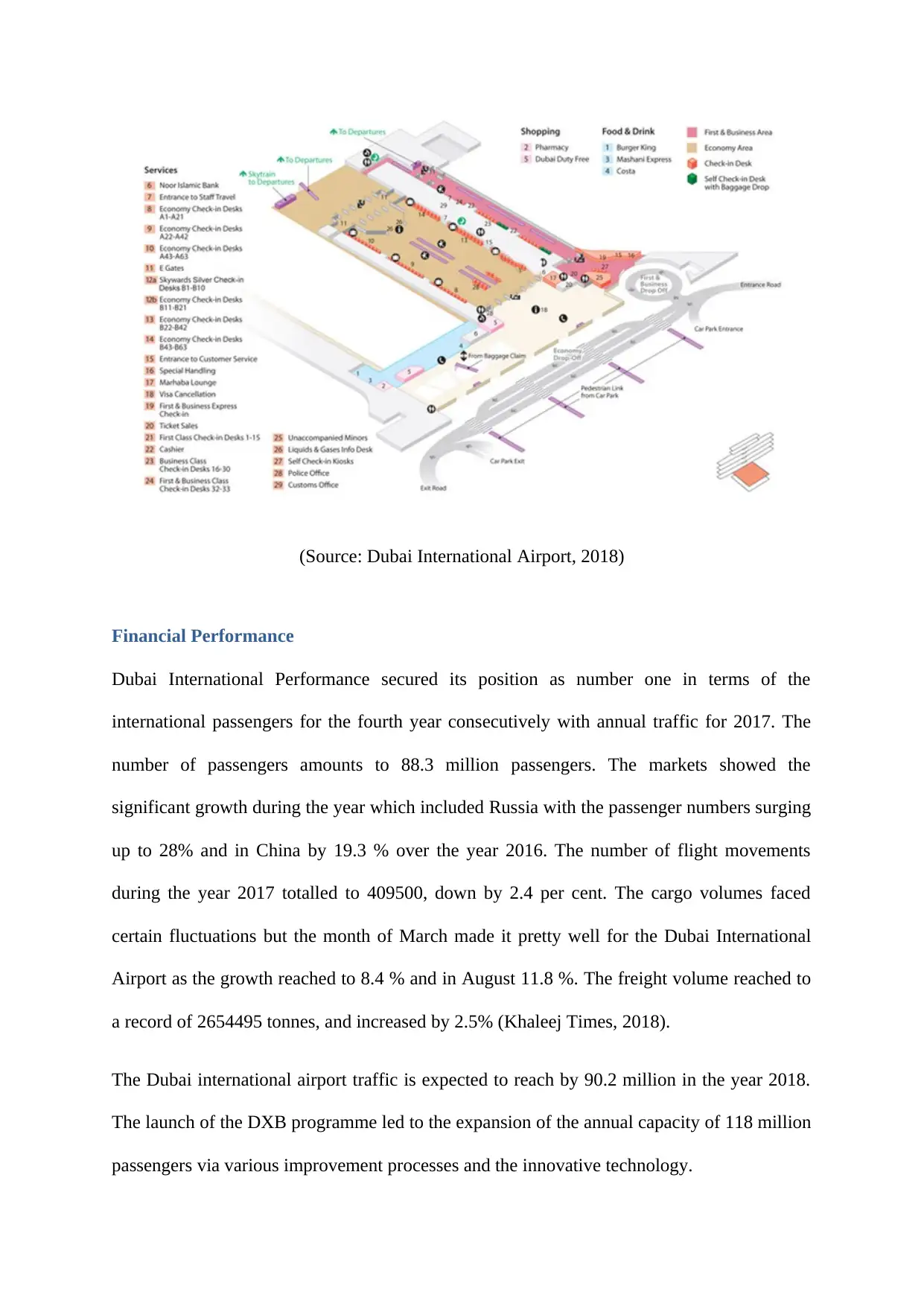
(Source: Dubai International Airport, 2018)
Financial Performance
Dubai International Performance secured its position as number one in terms of the
international passengers for the fourth year consecutively with annual traffic for 2017. The
number of passengers amounts to 88.3 million passengers. The markets showed the
significant growth during the year which included Russia with the passenger numbers surging
up to 28% and in China by 19.3 % over the year 2016. The number of flight movements
during the year 2017 totalled to 409500, down by 2.4 per cent. The cargo volumes faced
certain fluctuations but the month of March made it pretty well for the Dubai International
Airport as the growth reached to 8.4 % and in August 11.8 %. The freight volume reached to
a record of 2654495 tonnes, and increased by 2.5% (Khaleej Times, 2018).
The Dubai international airport traffic is expected to reach by 90.2 million in the year 2018.
The launch of the DXB programme led to the expansion of the annual capacity of 118 million
passengers via various improvement processes and the innovative technology.
Financial Performance
Dubai International Performance secured its position as number one in terms of the
international passengers for the fourth year consecutively with annual traffic for 2017. The
number of passengers amounts to 88.3 million passengers. The markets showed the
significant growth during the year which included Russia with the passenger numbers surging
up to 28% and in China by 19.3 % over the year 2016. The number of flight movements
during the year 2017 totalled to 409500, down by 2.4 per cent. The cargo volumes faced
certain fluctuations but the month of March made it pretty well for the Dubai International
Airport as the growth reached to 8.4 % and in August 11.8 %. The freight volume reached to
a record of 2654495 tonnes, and increased by 2.5% (Khaleej Times, 2018).
The Dubai international airport traffic is expected to reach by 90.2 million in the year 2018.
The launch of the DXB programme led to the expansion of the annual capacity of 118 million
passengers via various improvement processes and the innovative technology.
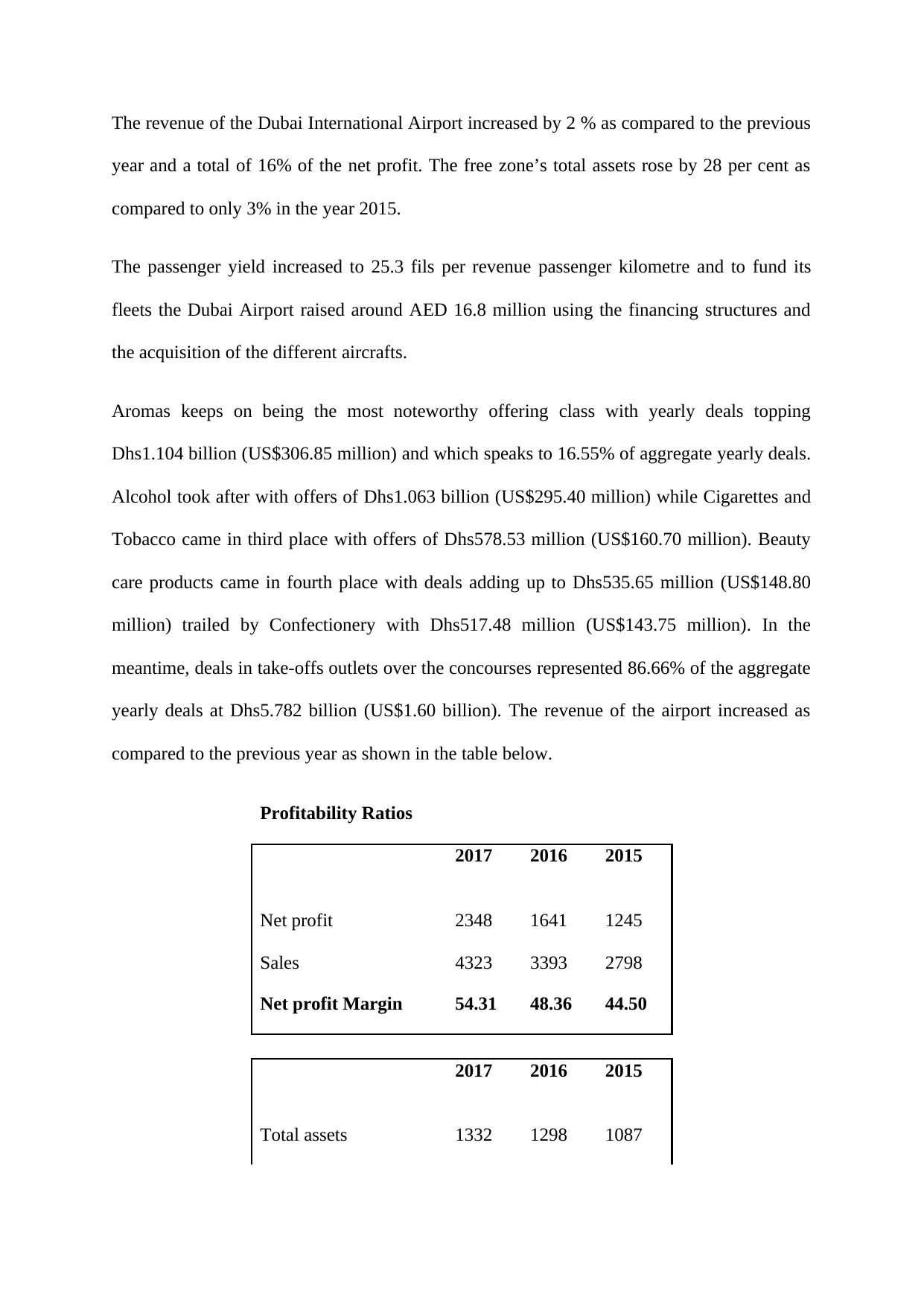
The revenue of the Dubai International Airport increased by 2 % as compared to the previous
year and a total of 16% of the net profit. The free zone’s total assets rose by 28 per cent as
compared to only 3% in the year 2015.
The passenger yield increased to 25.3 fils per revenue passenger kilometre and to fund its
fleets the Dubai Airport raised around AED 16.8 million using the financing structures and
the acquisition of the different aircrafts.
Aromas keeps on being the most noteworthy offering class with yearly deals topping
Dhs1.104 billion (US$306.85 million) and which speaks to 16.55% of aggregate yearly deals.
Alcohol took after with offers of Dhs1.063 billion (US$295.40 million) while Cigarettes and
Tobacco came in third place with offers of Dhs578.53 million (US$160.70 million). Beauty
care products came in fourth place with deals adding up to Dhs535.65 million (US$148.80
million) trailed by Confectionery with Dhs517.48 million (US$143.75 million). In the
meantime, deals in take-offs outlets over the concourses represented 86.66% of the aggregate
yearly deals at Dhs5.782 billion (US$1.60 billion). The revenue of the airport increased as
compared to the previous year as shown in the table below.
Profitability Ratios
2017 2016 2015
Net profit 2348 1641 1245
Sales 4323 3393 2798
Net profit Margin 54.31 48.36 44.50
2017 2016 2015
Total assets 1332 1298 1087
year and a total of 16% of the net profit. The free zone’s total assets rose by 28 per cent as
compared to only 3% in the year 2015.
The passenger yield increased to 25.3 fils per revenue passenger kilometre and to fund its
fleets the Dubai Airport raised around AED 16.8 million using the financing structures and
the acquisition of the different aircrafts.
Aromas keeps on being the most noteworthy offering class with yearly deals topping
Dhs1.104 billion (US$306.85 million) and which speaks to 16.55% of aggregate yearly deals.
Alcohol took after with offers of Dhs1.063 billion (US$295.40 million) while Cigarettes and
Tobacco came in third place with offers of Dhs578.53 million (US$160.70 million). Beauty
care products came in fourth place with deals adding up to Dhs535.65 million (US$148.80
million) trailed by Confectionery with Dhs517.48 million (US$143.75 million). In the
meantime, deals in take-offs outlets over the concourses represented 86.66% of the aggregate
yearly deals at Dhs5.782 billion (US$1.60 billion). The revenue of the airport increased as
compared to the previous year as shown in the table below.
Profitability Ratios
2017 2016 2015
Net profit 2348 1641 1245
Sales 4323 3393 2798
Net profit Margin 54.31 48.36 44.50
2017 2016 2015
Total assets 1332 1298 1087
Secure Best Marks with AI Grader
Need help grading? Try our AI Grader for instant feedback on your assignments.
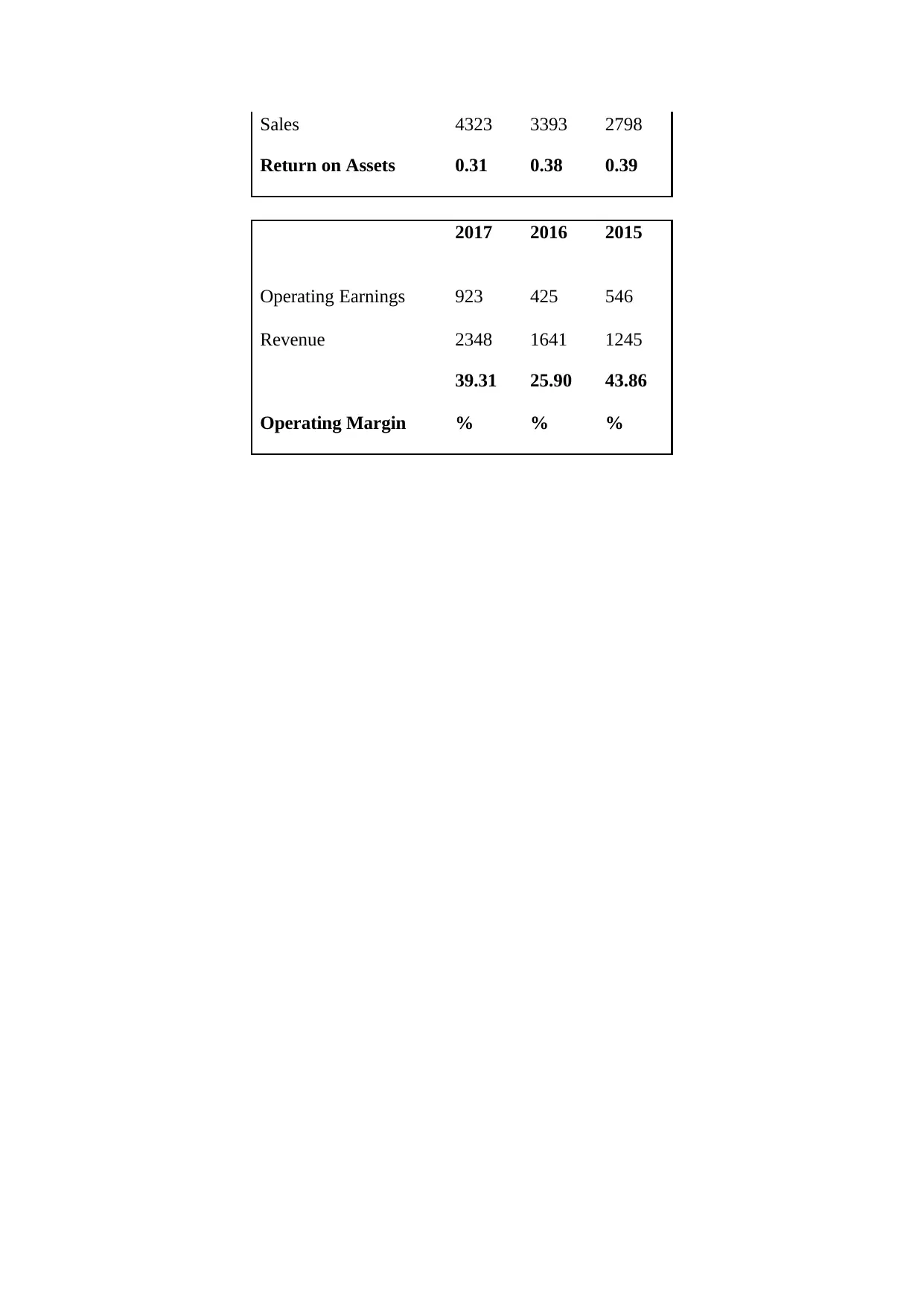
Sales 4323 3393 2798
Return on Assets 0.31 0.38 0.39
2017 2016 2015
Operating Earnings 923 425 546
Revenue 2348 1641 1245
Operating Margin
39.31
%
25.90
%
43.86
%
Return on Assets 0.31 0.38 0.39
2017 2016 2015
Operating Earnings 923 425 546
Revenue 2348 1641 1245
Operating Margin
39.31
%
25.90
%
43.86
%
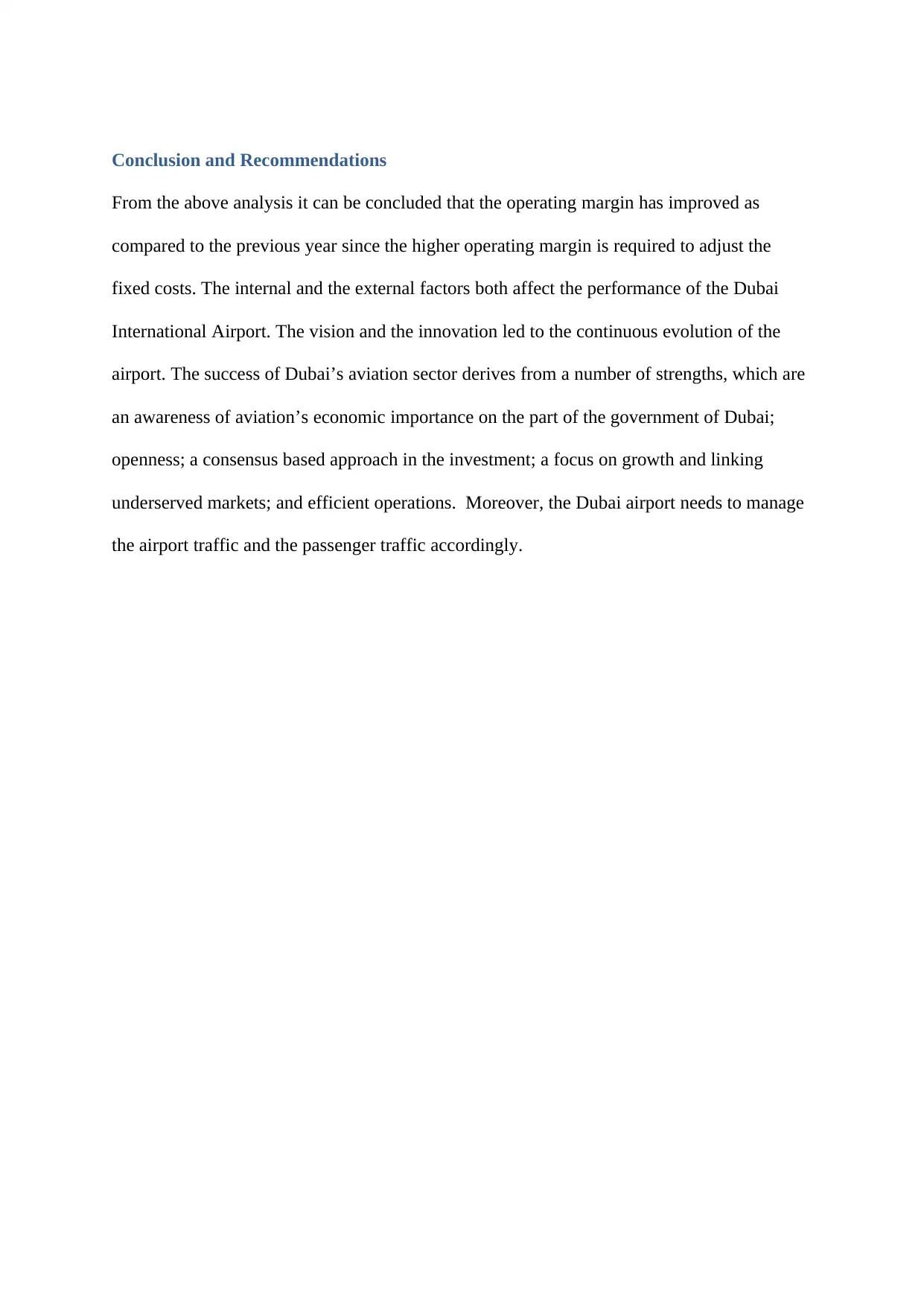
Conclusion and Recommendations
From the above analysis it can be concluded that the operating margin has improved as
compared to the previous year since the higher operating margin is required to adjust the
fixed costs. The internal and the external factors both affect the performance of the Dubai
International Airport. The vision and the innovation led to the continuous evolution of the
airport. The success of Dubai’s aviation sector derives from a number of strengths, which are
an awareness of aviation’s economic importance on the part of the government of Dubai;
openness; a consensus based approach in the investment; a focus on growth and linking
underserved markets; and efficient operations. Moreover, the Dubai airport needs to manage
the airport traffic and the passenger traffic accordingly.
From the above analysis it can be concluded that the operating margin has improved as
compared to the previous year since the higher operating margin is required to adjust the
fixed costs. The internal and the external factors both affect the performance of the Dubai
International Airport. The vision and the innovation led to the continuous evolution of the
airport. The success of Dubai’s aviation sector derives from a number of strengths, which are
an awareness of aviation’s economic importance on the part of the government of Dubai;
openness; a consensus based approach in the investment; a focus on growth and linking
underserved markets; and efficient operations. Moreover, the Dubai airport needs to manage
the airport traffic and the passenger traffic accordingly.
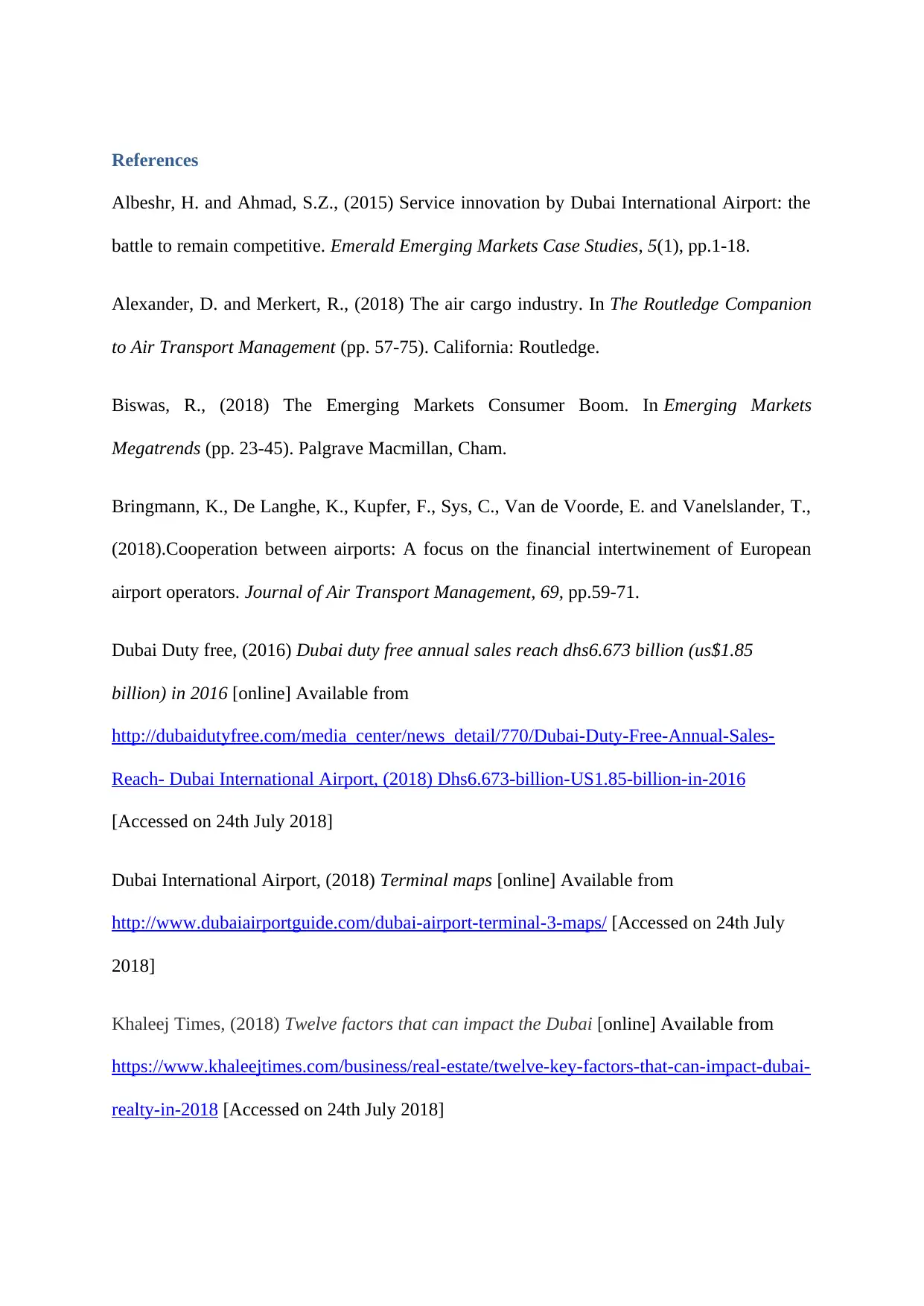
References
Albeshr, H. and Ahmad, S.Z., (2015) Service innovation by Dubai International Airport: the
battle to remain competitive. Emerald Emerging Markets Case Studies, 5(1), pp.1-18.
Alexander, D. and Merkert, R., (2018) The air cargo industry. In The Routledge Companion
to Air Transport Management (pp. 57-75). California: Routledge.
Biswas, R., (2018) The Emerging Markets Consumer Boom. In Emerging Markets
Megatrends (pp. 23-45). Palgrave Macmillan, Cham.
Bringmann, K., De Langhe, K., Kupfer, F., Sys, C., Van de Voorde, E. and Vanelslander, T.,
(2018).Cooperation between airports: A focus on the financial intertwinement of European
airport operators. Journal of Air Transport Management, 69, pp.59-71.
Dubai Duty free, (2016) Dubai duty free annual sales reach dhs6.673 billion (us$1.85
billion) in 2016 [online] Available from
http://dubaidutyfree.com/media_center/news_detail/770/Dubai-Duty-Free-Annual-Sales-
Reach- Dubai International Airport, (2018) Dhs6.673-billion-US1.85-billion-in-2016
[Accessed on 24th July 2018]
Dubai International Airport, (2018) Terminal maps [online] Available from
http://www.dubaiairportguide.com/dubai-airport-terminal-3-maps/ [Accessed on 24th July
2018]
Khaleej Times, (2018) Twelve factors that can impact the Dubai [online] Available from
https://www.khaleejtimes.com/business/real-estate/twelve-key-factors-that-can-impact-dubai-
realty-in-2018 [Accessed on 24th July 2018]
Albeshr, H. and Ahmad, S.Z., (2015) Service innovation by Dubai International Airport: the
battle to remain competitive. Emerald Emerging Markets Case Studies, 5(1), pp.1-18.
Alexander, D. and Merkert, R., (2018) The air cargo industry. In The Routledge Companion
to Air Transport Management (pp. 57-75). California: Routledge.
Biswas, R., (2018) The Emerging Markets Consumer Boom. In Emerging Markets
Megatrends (pp. 23-45). Palgrave Macmillan, Cham.
Bringmann, K., De Langhe, K., Kupfer, F., Sys, C., Van de Voorde, E. and Vanelslander, T.,
(2018).Cooperation between airports: A focus on the financial intertwinement of European
airport operators. Journal of Air Transport Management, 69, pp.59-71.
Dubai Duty free, (2016) Dubai duty free annual sales reach dhs6.673 billion (us$1.85
billion) in 2016 [online] Available from
http://dubaidutyfree.com/media_center/news_detail/770/Dubai-Duty-Free-Annual-Sales-
Reach- Dubai International Airport, (2018) Dhs6.673-billion-US1.85-billion-in-2016
[Accessed on 24th July 2018]
Dubai International Airport, (2018) Terminal maps [online] Available from
http://www.dubaiairportguide.com/dubai-airport-terminal-3-maps/ [Accessed on 24th July
2018]
Khaleej Times, (2018) Twelve factors that can impact the Dubai [online] Available from
https://www.khaleejtimes.com/business/real-estate/twelve-key-factors-that-can-impact-dubai-
realty-in-2018 [Accessed on 24th July 2018]
Paraphrase This Document
Need a fresh take? Get an instant paraphrase of this document with our AI Paraphraser
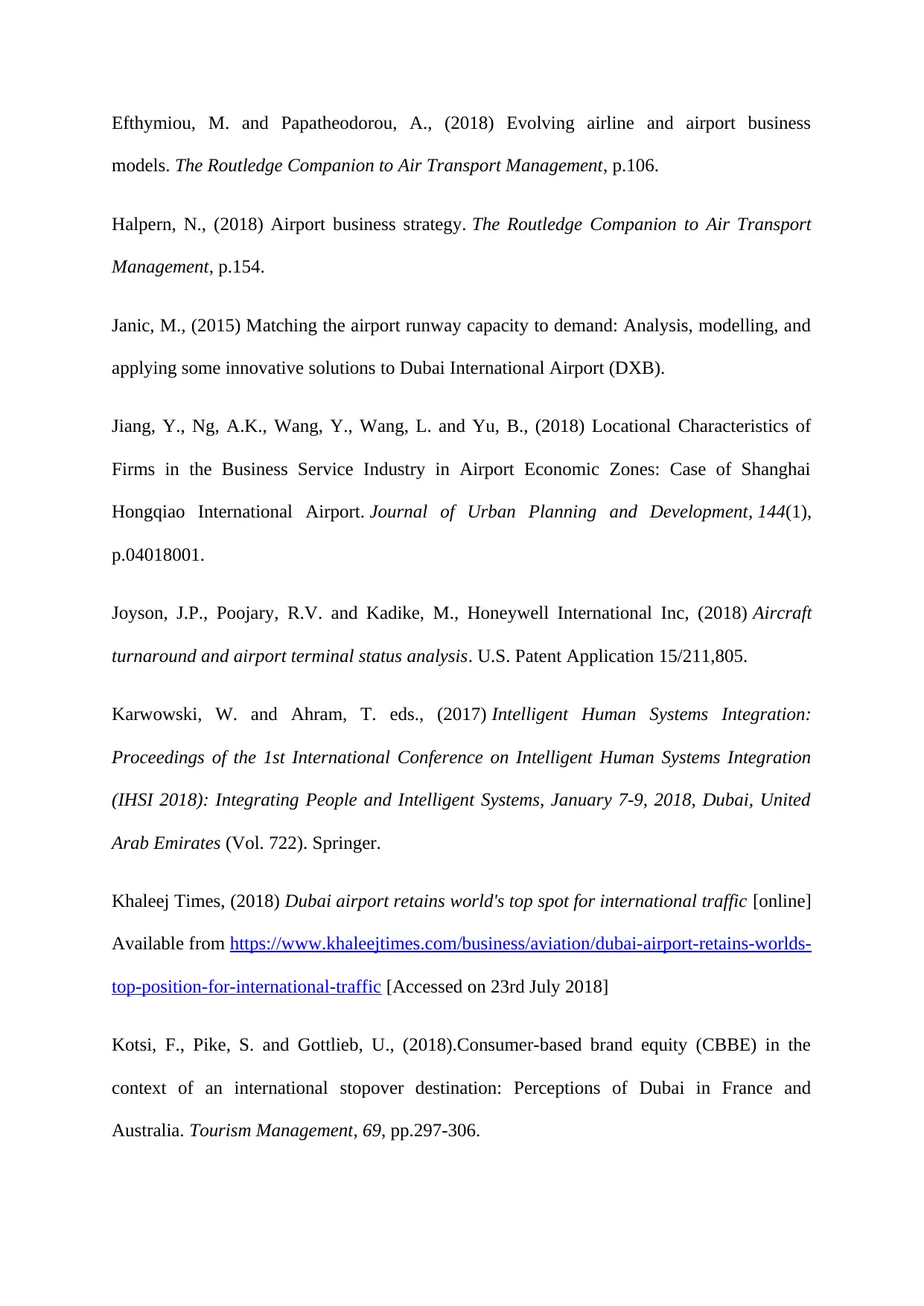
Efthymiou, M. and Papatheodorou, A., (2018) Evolving airline and airport business
models. The Routledge Companion to Air Transport Management, p.106.
Halpern, N., (2018) Airport business strategy. The Routledge Companion to Air Transport
Management, p.154.
Janic, M., (2015) Matching the airport runway capacity to demand: Analysis, modelling, and
applying some innovative solutions to Dubai International Airport (DXB).
Jiang, Y., Ng, A.K., Wang, Y., Wang, L. and Yu, B., (2018) Locational Characteristics of
Firms in the Business Service Industry in Airport Economic Zones: Case of Shanghai
Hongqiao International Airport. Journal of Urban Planning and Development, 144(1),
p.04018001.
Joyson, J.P., Poojary, R.V. and Kadike, M., Honeywell International Inc, (2018) Aircraft
turnaround and airport terminal status analysis. U.S. Patent Application 15/211,805.
Karwowski, W. and Ahram, T. eds., (2017) Intelligent Human Systems Integration:
Proceedings of the 1st International Conference on Intelligent Human Systems Integration
(IHSI 2018): Integrating People and Intelligent Systems, January 7-9, 2018, Dubai, United
Arab Emirates (Vol. 722). Springer.
Khaleej Times, (2018) Dubai airport retains world's top spot for international traffic [online]
Available from https://www.khaleejtimes.com/business/aviation/dubai-airport-retains-worlds-
top-position-for-international-traffic [Accessed on 23rd July 2018]
Kotsi, F., Pike, S. and Gottlieb, U., (2018).Consumer-based brand equity (CBBE) in the
context of an international stopover destination: Perceptions of Dubai in France and
Australia. Tourism Management, 69, pp.297-306.
models. The Routledge Companion to Air Transport Management, p.106.
Halpern, N., (2018) Airport business strategy. The Routledge Companion to Air Transport
Management, p.154.
Janic, M., (2015) Matching the airport runway capacity to demand: Analysis, modelling, and
applying some innovative solutions to Dubai International Airport (DXB).
Jiang, Y., Ng, A.K., Wang, Y., Wang, L. and Yu, B., (2018) Locational Characteristics of
Firms in the Business Service Industry in Airport Economic Zones: Case of Shanghai
Hongqiao International Airport. Journal of Urban Planning and Development, 144(1),
p.04018001.
Joyson, J.P., Poojary, R.V. and Kadike, M., Honeywell International Inc, (2018) Aircraft
turnaround and airport terminal status analysis. U.S. Patent Application 15/211,805.
Karwowski, W. and Ahram, T. eds., (2017) Intelligent Human Systems Integration:
Proceedings of the 1st International Conference on Intelligent Human Systems Integration
(IHSI 2018): Integrating People and Intelligent Systems, January 7-9, 2018, Dubai, United
Arab Emirates (Vol. 722). Springer.
Khaleej Times, (2018) Dubai airport retains world's top spot for international traffic [online]
Available from https://www.khaleejtimes.com/business/aviation/dubai-airport-retains-worlds-
top-position-for-international-traffic [Accessed on 23rd July 2018]
Kotsi, F., Pike, S. and Gottlieb, U., (2018).Consumer-based brand equity (CBBE) in the
context of an international stopover destination: Perceptions of Dubai in France and
Australia. Tourism Management, 69, pp.297-306.
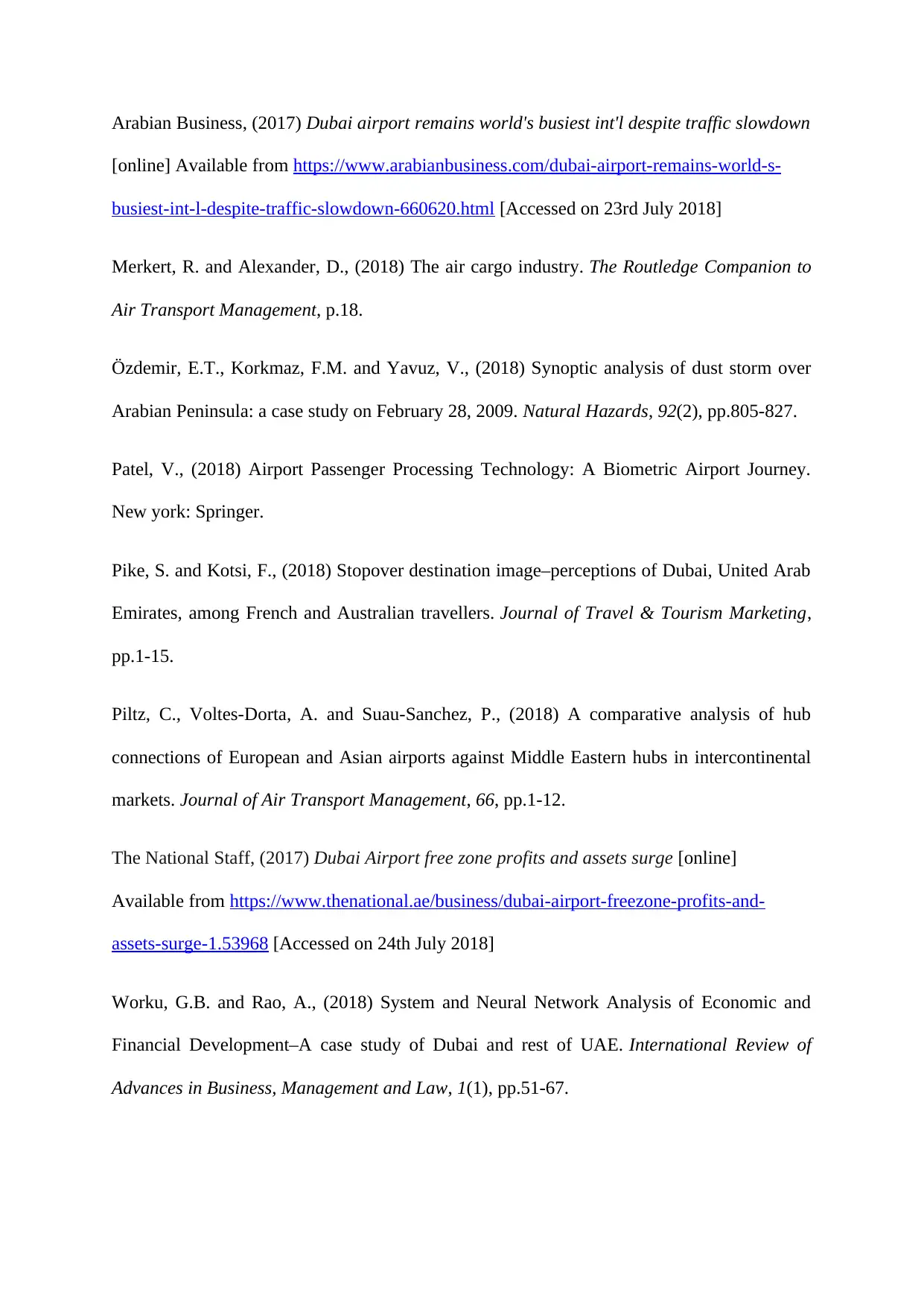
Arabian Business, (2017) Dubai airport remains world's busiest int'l despite traffic slowdown
[online] Available from https://www.arabianbusiness.com/dubai-airport-remains-world-s-
busiest-int-l-despite-traffic-slowdown-660620.html [Accessed on 23rd July 2018]
Merkert, R. and Alexander, D., (2018) The air cargo industry. The Routledge Companion to
Air Transport Management, p.18.
Özdemir, E.T., Korkmaz, F.M. and Yavuz, V., (2018) Synoptic analysis of dust storm over
Arabian Peninsula: a case study on February 28, 2009. Natural Hazards, 92(2), pp.805-827.
Patel, V., (2018) Airport Passenger Processing Technology: A Biometric Airport Journey.
New york: Springer.
Pike, S. and Kotsi, F., (2018) Stopover destination image–perceptions of Dubai, United Arab
Emirates, among French and Australian travellers. Journal of Travel & Tourism Marketing,
pp.1-15.
Piltz, C., Voltes-Dorta, A. and Suau-Sanchez, P., (2018) A comparative analysis of hub
connections of European and Asian airports against Middle Eastern hubs in intercontinental
markets. Journal of Air Transport Management, 66, pp.1-12.
The National Staff, (2017) Dubai Airport free zone profits and assets surge [online]
Available from https://www.thenational.ae/business/dubai-airport-freezone-profits-and-
assets-surge-1.53968 [Accessed on 24th July 2018]
Worku, G.B. and Rao, A., (2018) System and Neural Network Analysis of Economic and
Financial Development–A case study of Dubai and rest of UAE. International Review of
Advances in Business, Management and Law, 1(1), pp.51-67.
[online] Available from https://www.arabianbusiness.com/dubai-airport-remains-world-s-
busiest-int-l-despite-traffic-slowdown-660620.html [Accessed on 23rd July 2018]
Merkert, R. and Alexander, D., (2018) The air cargo industry. The Routledge Companion to
Air Transport Management, p.18.
Özdemir, E.T., Korkmaz, F.M. and Yavuz, V., (2018) Synoptic analysis of dust storm over
Arabian Peninsula: a case study on February 28, 2009. Natural Hazards, 92(2), pp.805-827.
Patel, V., (2018) Airport Passenger Processing Technology: A Biometric Airport Journey.
New york: Springer.
Pike, S. and Kotsi, F., (2018) Stopover destination image–perceptions of Dubai, United Arab
Emirates, among French and Australian travellers. Journal of Travel & Tourism Marketing,
pp.1-15.
Piltz, C., Voltes-Dorta, A. and Suau-Sanchez, P., (2018) A comparative analysis of hub
connections of European and Asian airports against Middle Eastern hubs in intercontinental
markets. Journal of Air Transport Management, 66, pp.1-12.
The National Staff, (2017) Dubai Airport free zone profits and assets surge [online]
Available from https://www.thenational.ae/business/dubai-airport-freezone-profits-and-
assets-surge-1.53968 [Accessed on 24th July 2018]
Worku, G.B. and Rao, A., (2018) System and Neural Network Analysis of Economic and
Financial Development–A case study of Dubai and rest of UAE. International Review of
Advances in Business, Management and Law, 1(1), pp.51-67.
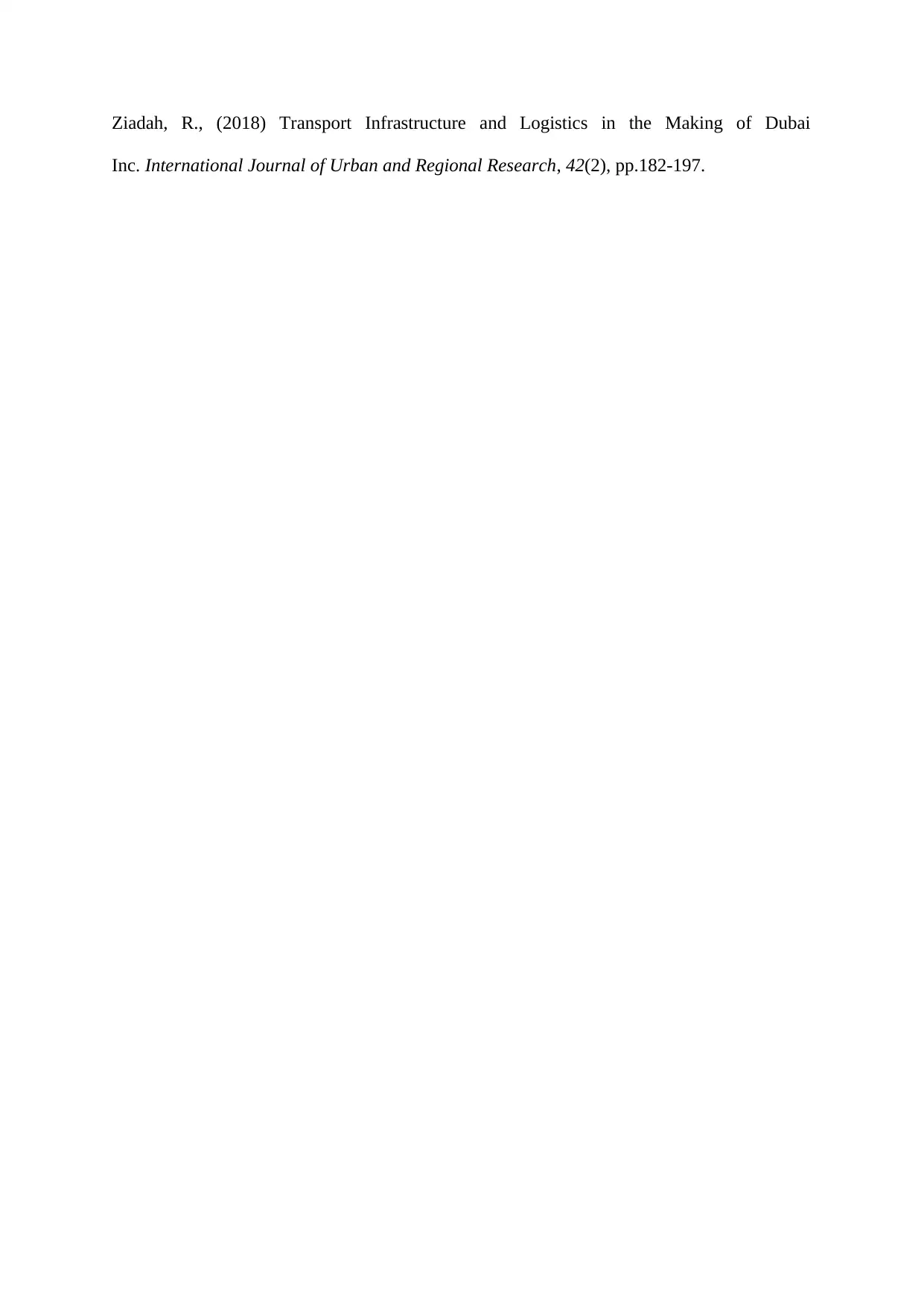
Ziadah, R., (2018) Transport Infrastructure and Logistics in the Making of Dubai
Inc. International Journal of Urban and Regional Research, 42(2), pp.182-197.
Inc. International Journal of Urban and Regional Research, 42(2), pp.182-197.
1 out of 16
Related Documents
Your All-in-One AI-Powered Toolkit for Academic Success.
+13062052269
info@desklib.com
Available 24*7 on WhatsApp / Email
![[object Object]](/_next/static/media/star-bottom.7253800d.svg)
Unlock your academic potential
© 2024 | Zucol Services PVT LTD | All rights reserved.





